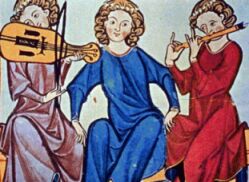|
Composers

Monteverdi

Palestrina

di Lasso

Hassler
|
 Madrigal
A secular song for unaccompanied
soloists, in which imitation between the voices is prominent
Madrigal
A secular song for unaccompanied
soloists, in which imitation between the voices is prominent .
In the beginning of the 14th century, composers in Italy started writing
madrigals. The blind madrigalist Francesco
Landini .
In the beginning of the 14th century, composers in Italy started writing
madrigals. The blind madrigalist Francesco
Landini was among the first composers identified with this particular genre. There
is much dispute over the source of the name "madrigal", and several
explanations, among which is "German
was among the first composers identified with this particular genre. There
is much dispute over the source of the name "madrigal", and several
explanations, among which is "German shepherd songs (mandriali)" or "songs
in the mother tongue (matricale)". The madrigal, as opposed to choir
songs of its time, was not based on a pre-given voice (cantus
firmus
shepherd songs (mandriali)" or "songs
in the mother tongue (matricale)". The madrigal, as opposed to choir
songs of its time, was not based on a pre-given voice (cantus
firmus ).
In the 16th century, after a period
of some decline, the madrigal reappeared as a vocal ).
In the 16th century, after a period
of some decline, the madrigal reappeared as a vocal contrapuntal
contrapuntal polyphonic form of secular content (the motet
polyphonic form of secular content (the motet was its religious parallel). Madrigals of
that time were written for popular poems about love and affection. Palestrina
was its religious parallel). Madrigals of
that time were written for popular poems about love and affection. Palestrina (who wrote religious madrigals, too), Orlando
di Lasso
(who wrote religious madrigals, too), Orlando
di Lasso ,
Gesualdo ,
Gesualdo and Monteverdi
and Monteverdi were among the madrigalists of this century.
There were others, outside of Italy
were among the madrigalists of this century.
There were others, outside of Italy (such as Hassler
(such as Hassler in Germany and
Victoria
in Germany and
Victoria in Spain
in Spain )
who composed in this field.
Madrigals used renaissance )
who composed in this field.
Madrigals used renaissance modes
modes ,
for the major-minor system was not yet set as the main methodology in customary
scales for composition. ,
for the major-minor system was not yet set as the main methodology in customary
scales for composition.


 The madrigal's religious brother-form is the
motet
The madrigal's religious brother-form is the
motet
|
Xtend
 Listen
Listen
 Period
Period
 Dictionary
Dictionary
 Internet
Internet
 Projects
Projects
 Finders
Finders
|